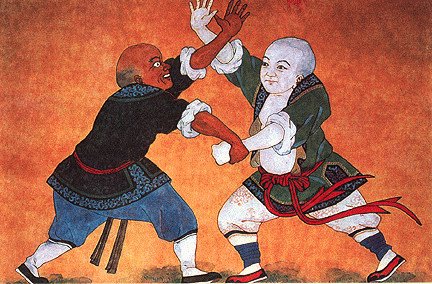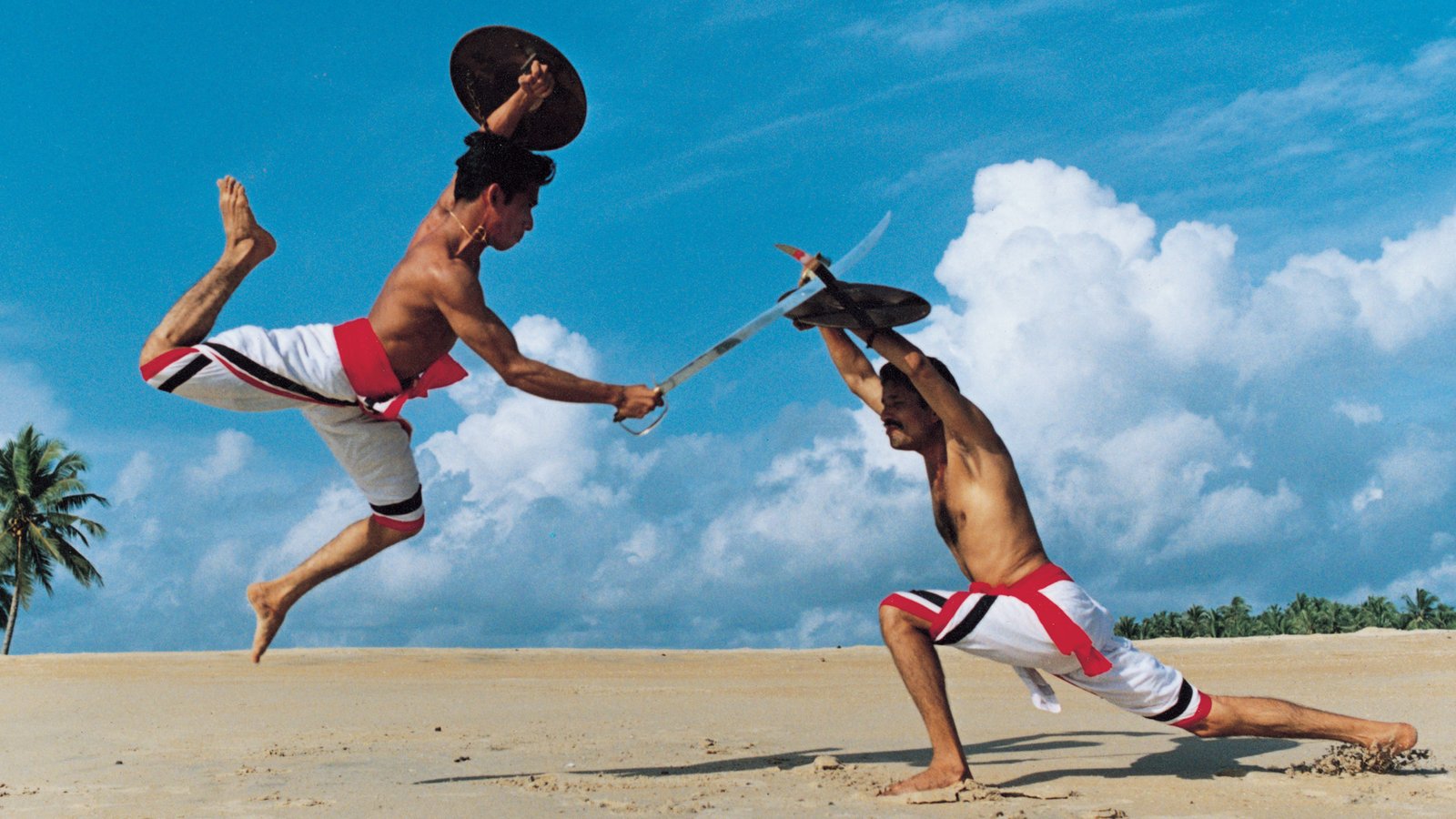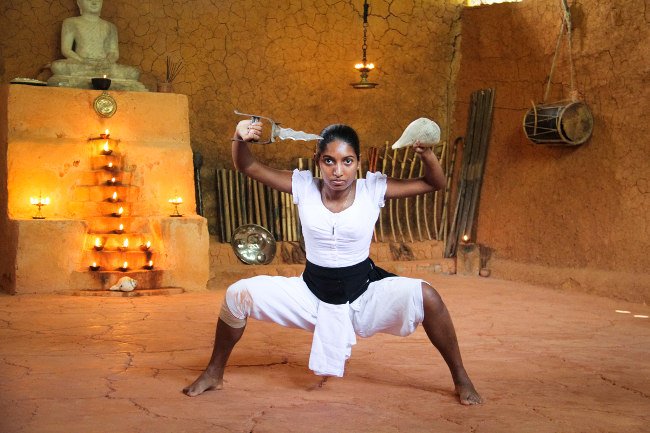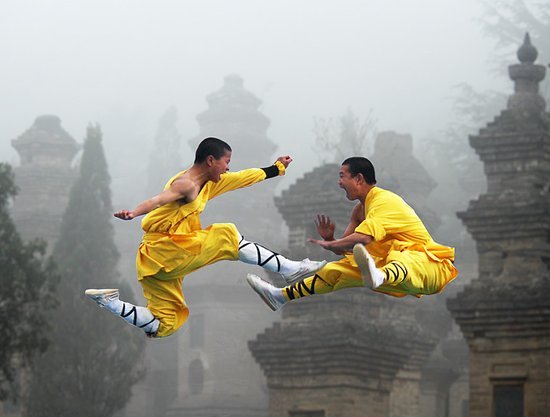The Wild Leaps of Awakening – Bodhidharma and Martial Arts

In this final part of the trilogy on Bodhidharma, we shall look into the pivotal role played by Bodhidharma in turning martial arts into a fine art of awakening. Through him and other masters of his genre, Indian, Chinese and Sri Lankan martial arts came to share many commonalities and became extensions of inner peace, by deriving inspiration from Buddhist principles. We shall also briefly see how traditional medicine derived inspiration from Buddhism.
View other parts of this Trilogy at
Part I – Transcending Movement and Stillness – The Life of Bodhidharma |
Part II – Breaking the Silence – The Teachings of Bodhidharma |
Contents
The Enigmatic Bodhidharma
Bodhidharma, the master who stayed in unmoving meditation for nine years in the cave behind the Shaolin Temple, is also well-known as a master of some of the most dynamic forms of martial arts. The synergy between Buddhism and Taoism in China led to the evolution of one of the finest and effective ways to cultivate a healthy body for a healthy mind. These included the slow-moving forms of dynamic meditation such as Chi-kung (also written as Qigong), and martial arts forms such as Kung-Fu.
Back in the land of Bodhidharma’s birth, South India, having long forgotten the heritage of Buddhist monks, yogis and maha-siddhas in the heart land of the old Tamilakam (the present day Tamil Nadu and Kerala), Bodhidharma remains just a vague memory – a Buddhist master, an adept in martial arts and a holder of esoteric knowledge on healing and medicinal herbs, and so on. Mostly, these are fragments of memory re-acquired by those who travelled from South India to China in search of martial arts. Often, people are perplexed about how Buddhism, martial arts and medical knowledge came together in Bodhidharma.
And, in the eastern lands of China, Japan, and so on, where the peaceful sitting tradition of Bodhidharma spread widely as Chan / Zen school of Buddhism, at least some peaceful meditators wonder how the martial arts tradition of Shaolin can find its roots in Bodhidharma, the silent meditator.In other words, they wonder, how Bodhidharma and martial arts are connected.
At the surface, martial arts may even sound contradictory to the path of peace that Buddhism stands for. However, martial arts as practiced by some schools of Buddhism have nothing do with attacking or violence, but are finer methods of inner cultivation. We shall come back to it soon. (It is also to be noted that martial art is not an essential practice of Buddhism, but an optional skillful support used only by some schools of Buddhism – particularly, the slow-moving meditational forms of martial arts).
Turning Martial Arts into a Dance of Awakening
Bodhidharma was one of the few who became instrumental in a large scale wisdom-exchange between India and China. In this process, there were also exchanges between the martial arts traditions of China, Japan 1, South India and Sri Lanka2. Bodhidharma and other masters of his genre revitalized these martial arts with a deeper meaning by infusing Buddhist principles into them.
Some forms of Chinese martial arts preceded Bodhidharma. The Master gave a new dimension to it by structuring it on Buddhist principles and then teaching the monks of Shaolin on how to use it as a support for their path of awakening. Thus, instead of being a display of aggression and force, the new form of Shaolin Kung Fu turned into a dynamic method for cultivating a peaceful mind, and at the same time a powerful tool of defense. Bodhidharma took the slow moving forms of Chinese martial arts such as Chi-kung (also written as Qigong), gave it a new foundation based on the Buddhist principles and adapted them into the Buddhist practice. These forms help in maintaining a healthy body for a deeper meditation.

The 18 movements taught by Bodhidharma came to be known as the ‘Eighteen Hands of Lohan (Arhat)’. Buddhist Chi-kung can be considered as a creative synthesis that happened in China as there are no equivalent slow-forms known in India. He also authored a text on Chi-kung known as Yijin Jing in Chinese. The new form of Shaolin Kung Fu became widely popular and also inspired similar traditions in Japan. There are paintings in Shaolin temple depicting a dark skinned Indian monk training the light skinned Chinese counter parts.
The Lion Meets the Dragon – Martial Art Traditions of India and China
Shaolin Kung Fu shares common Buddhist principles with Kalaripayattu of Kerala in South India (particularly, the Southern form of Kalaripayattu), Silambam of Tamil Nadu in South India and Angampora of Sri Lanka. However, the forms, weapons, etc. used in Kung Fu are at variance with the latter forms. So, it may be inferred that the Indian and Chinese systems have independent origins but evolved later by incorporating the same Buddhist principles, and thus came to possess some commonalities. In contrast, Kalaripayattu and Angampora share much in common even in form and weapons. So, the Indian and Sri Lankan systems share a common origin, and later branched off with local differences. The Buddhist principle in Kalaripayattu and Angampora would have been incorporated at a time before they branched off into different systems.

Angampora of Sri Lanka is practiced after paying homage to the Buddha, and their academies have an altar with a Buddha image as the central piece. However, Kalaripayattu of Kerala does not recognize its Buddhist connections currently as Buddhism has been long forgotten there. Modern Kalaris (academies of Kalaripayattu) these days mostly have a lamp, an Om syllable or some divine representations as the central piece in their altars.

In case of martial arts, the relation between India and China is most likely mutual in nature. Shaolin monastery had Indian teachers even before Bodhidharma, and Chinese also travelled to India to learn Buddhism. So, there could also be influence of Chinese Taoist traditions in the Indian and Sri Lankan martial arts coming various masters.
The Power of Peace – the Buddhist Principles in Martial Arts
Let us see some of the principles shared by the martial arts traditions linked together through Bodhidharma. As we have seen earlier, according to Bodhidharma,
To transcend motion and stillness is the highest meditation.
Bodhidharma’s martial arts are also founded on this principle. Movements in these martial arts are a fine display of inner stillness and ease, expressed as mindful and vigilant actions. No matter whether one is training in a solo form or training with an opponent, the martial arts performance proceeds without losing the inner ease for a moment. A move is never supposed to be the result of mental agitation or fear. At the same time, the peace should never give way into slumber and mental sinking. Thus, one maintains a peaceful, yet vibrantly vigilant awareness all through the martial arts performance. This is also how one is supposed to deal with all aspects of the worldly life in the Way of awakening.

Further, Bodhidharma’s martial arts also have a strong basis on four foundations of mindfulness. The practice of the four foundations of mindfulness that the Buddha taught is about being attentive to the stillness and movement of body, feelings, thoughts and phenomenal appearances. One attends to these with mindfulness, vigilance and ardency, while taking care not to slip into covetousness or hatred with respect to whatever arises. Gaining proficiency in these principles of mindfulness is the key to mastery in these martial arts too.
The Buddha taught that confused and effortful reactions to Samsara exhaust us and enslave us more and more in Samsara. Applying this principle to martial arts, one remains mindful not to apply careless and unnecessary force to either the opponent or even to one’s own muscles and joints. Thus, one remains perfectly relaxed and free from tightness while facing an opponent (just in the same way as how one is supposed to face any adversity in life). The Buddha taught that one should train one’s awareness by maintaining it neither too loose nor too tight. He used the simile of playing a string instrument. For the perfect music to play out, the string should neither be tight nor be loose.
It does not end there. In Mahayana, the Buddha taught that skillfully working with the power of Samsara itself is the way to end Samsara. In the same way, in Bodhidharma’s martial arts, one skillfully works with the force and strikes of the opponent himself to defeat the opponent. Thus, these martial arts forms teach the principle of yielding. One deflects the force of the opponent through skillfully maneuvering one’s body, and at the right occasion turning the opponent’s force towards his own defeat. This is again, in the same way as the Buddha teaching on how one’s own destructive emotions can be skillfully dealt with and defeated by their own power.
Though these principles are common to Kung Fu, Kalaripayattu and Angompora (and possibly to Silambam), nowadays it is rare to find practitioners of these martial arts who bring these principles of inner cultivation into their practice.
Wild Leaps in Training the Mind – Martial Art Forms in the Buddhist Practice
We have seen how martial art forms progressed with the incorporation of Buddhist principles. Now, let us see how Bodhidharma used them in teaching the Way of awakening. In particular, he used them in the Way of Gradual Entrance (Entering the Way through Practice).

As it is obvious, a peaceful martial art form is also one of the ways in which the sitting practice of mindfulness can be extended into a dynamic practice of movement – so as to extend mindfulness and peace into all post-meditation actions. Further, the cultivation of endurance, stability and suppleness, such as through the horse stance of Chinese martial arts, also helps in cultivating the first practice of the entrance to the Way, namely that of ‘accepting suffering’, by not being shaken by difficulties (refer Entering the Way through Practice).. While taking hardship in the martial arts training leads to the cultivation of strong body and mind, taking hardship in the wisdom training of Buddhism leads to the cultivation of wisdom awareness and the strength not to be fooled by the ways of Samsara.
Taking that forward, not reacting blindly to the moves of the opponent and not losing control through opponent’s surprise moves, are helpful in cultivating the second practice, namely that of ‘adapting to condition’ and cultivating great evenness. In this way, one can learn how not to succumb to emotional turbulence and keep the lamp of inner wisdom glow steadily.

Being a courageous warrior who mindfully performs the right moves without falling into hopes and fears, is also how a Bodhisattva warrior enters the Way (of awakening), seeking nothing, and selflessly acting for others. And, that is the third practice of the entrance to the Way. A Bodhisattva is often compared to a courageous warrior, in that a Bodhisattva dedicates his life to the benefit of other beings without bias, and then does every moment’s action just for that sake – without worrying about protecting self or getting into convoluted plans.
So far we have seen how Bodhidharma and martial arts are connected, and how he turned martial arts into a play of awakening. Finally, we shall also briefly see how Bodhidharma is connected with healing and traditional medicine.
The Healing Touch – Connection with Healing and Medicine
Bodhidharma and other masters like him were also instrumental in forging another deep connection between the Buddhist Siddhas of South India and Sri Lanka, and the Taoist and Buddhist masters of China. The martial art traditions of these regions also share a common knowledge of the key-points of the body that can be used for both self-defense and healing. Working with these acupressure points is known in Kerala as Marma-kala, in Tamil Nadu as Varma-kalai and in Sri Lanka as Maru-kala. The Chinese have a much more elaborate system of acupressure points that is well preserved even today. Chi-kung practice also has its own elaborate healing system.
The Buddhist masters through their mindfulness practice of the body could study the effect in the body produced by various herbs and minerals as well as various emotional states. Thus, they could figure out details about how herbs, meditation and exercise methods can be utilized systematically in maintaining the balance of a healthy body and mind. As a result, in India, they contributed to the development and systematization of Medical systems such as Ayurveda and the South Indian Siddha Medicine. (As it may be noted, even before Bodhidharma, the Buddhist scholar and mahasiddha Nagarjuna was an adept in Ayurveda. Also, the much acclaimed Ashtangahridayam, the standard manual of Ayurveda, was a composition by a Buddhist master named Vagbhata.)
As masters such as Bodhidharma travelled to China and as Chinese came to India in search of Buddhism, there were also widespread mutual exchanges of their medical knowledge. Particularly, the South Indian Siddha medical system and the Chinese medical system came to share many common principles due to these exchanges.
Concluding Remarks
Through this three part series, we have tried to paint a picture of the life and teachings of Bodhidharma, and thus bring some light into the enigmatic accounts of Bodhidharma.
The Buddha showed a path beyond religion that showed the original simplicity and perfection of mind (see, give link to path beyond religion). In spite of that, due to the general habits of humanity, religiosity creeped into even various Buddhist systems from time to time. However, the open culture of Buddhism paved way for many visionary masters who could again step beyond such religiosity and bring the focus back to the essence of realizing one’s own nature. Bodhidharma was such a revolutionary master who dispelled religiosity and drove disciples straight into the essence of Buddhism. As an example of how every walk of life can be turned into a Way of Bodhi (awakening), he showed how even martial arts can be turned into a meaningful and peaceful activity, a wild leap of awakening.
View the Complete Trilogy at
Bodhidharma – a Trilogy on His Life and Teachings
Authors – Yogini Abhaya Devi & Yogi Prabodha Jnana
- Like a bird flying through the vast expanse - September 21, 2021
- The Liberation Story of Punnika, a Girl from an Oppressed Caste - March 31, 2021
- Ancient Buddha Statues of Kerala - October 11, 2018


Great and Lovely Presentation.
Humble Salutations at the Lotus feet of the Great Masters.
i would love to hear about medicines and martial arts told by bodhidharma